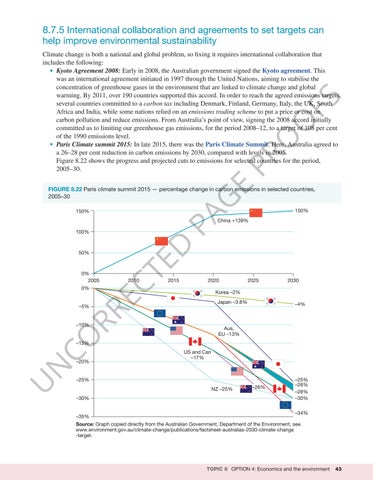“c08EconomicsAndTheEnvironment_PrintPDF” — 2022/6/6 — 17:03 — page 43 — #43
8.7.5 International collaboration and agreements to set targets can help improve environmental sustainability
E
PR
O
O
FS
Climate change is both a national and global problem, so fixing it requires international collaboration that includes the following: • Kyoto Agreement 2008: Early in 2008, the Australian government signed the Kyoto agreement. This was an international agreement initiated in 1997 through the United Nations, aiming to stabilise the concentration of greenhouse gases in the environment that are linked to climate change and global warming. By 2011, over 190 countries supported this accord. In order to reach the agreed emissions targets, several countries committed to a carbon tax including Denmark, Finland, Germany, Italy, the UK, South Africa and India, while some nations relied on an emissions trading scheme to put a price or cost on carbon pollution and reduce emissions. From Australia’s point of view, signing the 2008 accord initially committed us to limiting our greenhouse gas emissions, for the period 2008–12, to a target of 108 per cent of the 1990 emissions level. • Paris Climate summit 2015: In late 2015, there was the Paris Climate Summit. Here, Australia agreed to a 26–28 per cent reduction in carbon emissions by 2030, compared with levels in 2005. Figure 8.22 shows the progress and projected cuts to emissions for selected countries for the period, 2005–30.
G
FIGURE 8.22 Paris climate summit 2015 — percentage change in carbon emissions in selected countries, 2005–30 150%
PA
150%
China +139%
D
100%
2010
CO RR EC
0% 2005
TE
50%
2015
2020
0%
2025
2030
Korea –2% Japan –3.8%
–5%
–10%
–4%
Aus, EU –13%
–15%
U
N
–20%
US and Can –17%
–25% NZ –25% –30%
–35%
–26%
–25% –26% –28% –30% –34%
Source: Graph copied directly from the Australian Government, Department of the Environment, see www.environment.gov.au/climate-change/publications/factsheet-australias-2030-climate-change -target.
TOPIC 8 OPTION 4: Economics and the environment
43





















































